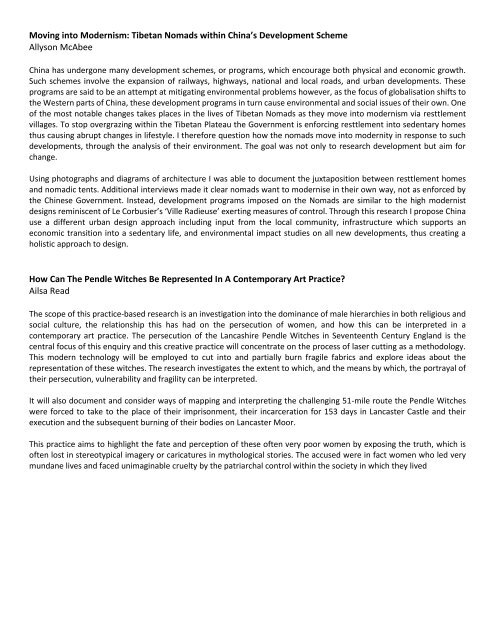Conference Programme FULL (1)
You also want an ePaper? Increase the reach of your titles
YUMPU automatically turns print PDFs into web optimized ePapers that Google loves.
Moving into Modernism: Tibetan Nomads within China’s Development Scheme<br />
Allyson McAbee<br />
China has undergone many development schemes, or programs, which encourage both physical and economic growth.<br />
Such schemes involve the expansion of railways, highways, national and local roads, and urban developments. These<br />
programs are said to be an attempt at mitigating environmental problems however, as the focus of globalisation shifts to<br />
the Western parts of China, these development programs in turn cause environmental and social issues of their own. One<br />
of the most notable changes takes places in the lives of Tibetan Nomads as they move into modernism via resttlement<br />
villages. To stop overgrazing within the Tibetan Plateau the Government is enforcing resttlement into sedentary homes<br />
thus causing abrupt changes in lifestyle. I therefore question how the nomads move into modernity in response to such<br />
developments, through the analysis of their environment. The goal was not only to research development but aim for<br />
change.<br />
Using photographs and diagrams of architecture I was able to document the juxtaposition between resttlement homes<br />
and nomadic tents. Additional interviews made it clear nomads want to modernise in their own way, not as enforced by<br />
the Chinese Government. Instead, development programs imposed on the Nomads are similar to the high modernist<br />
designs reminiscent of Le Corbusier’s ‘Ville Radieuse’ exerting measures of control. Through this research I propose China<br />
use a different urban design approach including input from the local community, infrastructure which supports an<br />
economic transition into a sedentary life, and environmental impact studies on all new developments, thus creating a<br />
holistic approach to design.<br />
How Can The Pendle Witches Be Represented In A Contemporary Art Practice?<br />
Ailsa Read<br />
The scope of this practice-based research is an investigation into the dominance of male hierarchies in both religious and<br />
social culture, the relationship this has had on the persecution of women, and how this can be interpreted in a<br />
contemporary art practice. The persecution of the Lancashire Pendle Witches in Seventeenth Century England is the<br />
central focus of this enquiry and this creative practice will concentrate on the process of laser cutting as a methodology.<br />
This modern technology will be employed to cut into and partially burn fragile fabrics and explore ideas about the<br />
representation of these witches. The research investigates the extent to which, and the means by which, the portrayal of<br />
their persecution, vulnerability and fragility can be interpreted.<br />
It will also document and consider ways of mapping and interpreting the challenging 51-mile route the Pendle Witches<br />
were forced to take to the place of their imprisonment, their incarceration for 153 days in Lancaster Castle and their<br />
execution and the subsequent burning of their bodies on Lancaster Moor.<br />
This practice aims to highlight the fate and perception of these often very poor women by exposing the truth, which is<br />
often lost in stereotypical imagery or caricatures in mythological stories. The accused were in fact women who led very<br />
mundane lives and faced unimaginable cruelty by the patriarchal control within the society in which they lived


